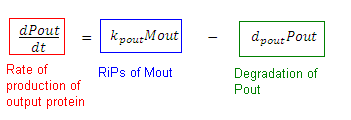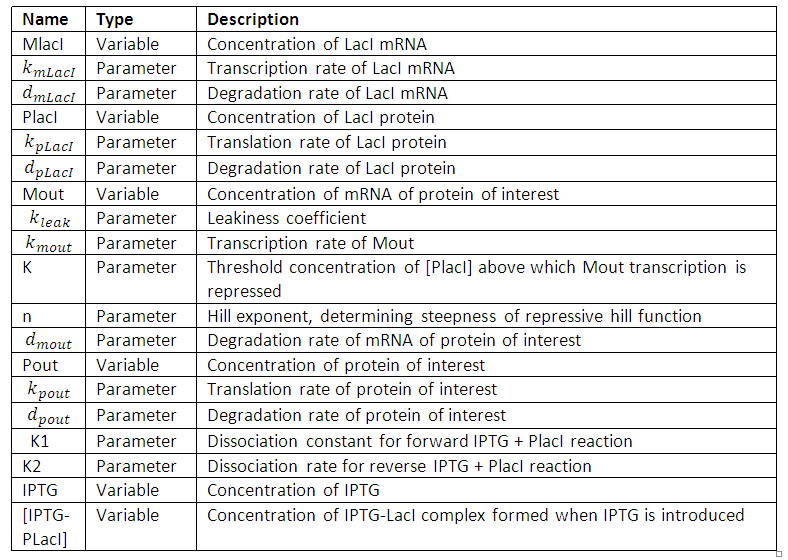Team:Imperial College London/Drylab/M1/Protein production/Analysis/Detailed
From 2009.igem.org
(→In the absence of IPTG) |
m (→Genetic circuit) |
||
| (36 intermediate revisions not shown) | |||
| Line 1: | Line 1: | ||
{{Imperial/09/TemplateTop}} | {{Imperial/09/TemplateTop}} | ||
| + | {{Imperial/09/Tabs/M1/Modelling}} | ||
| - | ==In the absence of IPTG | + | =Genetic circuit= |
| + | [[Image:m1gci.jpg | 700px]] | ||
| + | |||
| + | =Equations= | ||
| + | <font face='Calibri' size='3'><b>In the absence of IPTG</b></font><br><br> | ||
<b>Equation 1:</b> Equation describing the rate of transcription of LacI MRNA (M<sub>LacI</sub>): <br> | <b>Equation 1:</b> Equation describing the rate of transcription of LacI MRNA (M<sub>LacI</sub>): <br> | ||
| - | [[Image:II09_MOD1_M1.jpg]]<br><br> | + | [[Image:II09_MOD1_M1.jpg|centre]]<br><br> |
k<sub>mlacI</sub> is the transcription rate of M<sub>lacI</sub> (a measure of promoter strength) and d<sub>mlacI</sub> is the degradation rate. At steady state: | k<sub>mlacI</sub> is the transcription rate of M<sub>lacI</sub> (a measure of promoter strength) and d<sub>mlacI</sub> is the degradation rate. At steady state: | ||
| - | [[Image:II09_M1_SS1.jpg| | + | [[Image:II09_M1_SS1.jpg|200px|centre]] |
| + | <br><br> | ||
| + | <b>Equation 2:</b> Equation describing the rate of translation of LacI protein (P<sub>lacI</sub>) | ||
| + | |||
| + | [[Image:II09_MOD1_M1_E2.jpg|centre]]<br> | ||
| + | At steady state:<br> | ||
| + | [[Image:II09_M1_SS2.jpg|150px|centre]] | ||
| + | |||
| + | where k<sub>lacI</sub> is the translation rate of lacI protein and d<sub>placI</sub> is the degradation rate of P<sub>lacI</sub>.Equations 3 and 4 describe the transcription and translation of the protein of interest P<sub>out</sub>. | ||
| + | |||
| + | |||
| + | <b>Equation 3:</b> Transcription of P<sub>out</sub><br><br> | ||
| + | Unlike in the previous case, the output promoter is inducible. In the absence of further information, we model the effect of LacI on transcription/ POPS activity with a Hill function, which represses when amounts are above the threshold K, and activates when P<sub>lacI</sub> amounts fall below threshold. Such assumption can be revised in the light of contradicting experimental data. | ||
| + | |||
| + | [[Image:II09_MOD1_M1_E3.jpg|centre]] | ||
| + | |||
| + | At steady state: | ||
| + | [[Image:II09_M1_SS3.jpg|500px|centre]] | ||
| + | |||
| + | <b>Equation 4:</b> Equation describing the rate of translation of protein of interest P<sub>out</sub>: | ||
| + | |||
| + | [[Image:II09_MOD1_M1_E4.jpg|centre]] | ||
| + | |||
| + | At steady state: | ||
| + | [[Image:II09_M1_SS4.jpg|500px|centre]] | ||
| + | |||
| + | <font face='Calibri' size='3'><b>When IPTG is introduced</b></font><br><br> | ||
| + | When IPTG is added into the system, LacI can bind to it, forming an intermediate complex [IPTG-LacI]: | ||
| + | [[Image:II09_M1_reaction.jpg|centre]] | ||
| + | k1 and k2 are the dissociation constants of the forward and reverse reactions. Therefore, we can modify Equation 2 to include the effects of IPTG on the LacI system as follows:<br><br> | ||
| + | <b>Equation 2 modified:</b> | ||
| + | [[Image:II09_M1_EQ2A.jpg|650px|centre]] | ||
| + | Note that now, the effects of IPTG have been included. The –k2[Plac][IPTG] term contributes negatively, as it removes PLac from the system. The k1[IPTG-Plac] term contributes positively, as it re-stores the levels of PLac in the system. | ||
| + | The equations that describe the evolution of IPTG and IPTG-LacI are-<br> | ||
| + | |||
| + | <b>Equation 5:</b> Rate of change of IPTG in the system: | ||
| + | [[Image:II09_M1_EQ5.jpg|centre]] | ||
| - | + | <b>Equation 6:</b> Rate of change of intermediate [IPTG-Plac] complex in the system. | |
| + | [[Image:II09_M1_EQ6.jpg|centre]] | ||
| - | ==Parameters | + | ==Parameters== |
| + | [[Image:II09_M1_PARAMETERS.jpg|400px]] | ||
| + | <!-- | ||
| + | [https://2009.igem.org/wiki/Team:Imperial_College_London/Drylab/Protein_Production Click here to go back to the previous page] | ||
| + | --> | ||
{{Imperial/09/TemplateBottom}} | {{Imperial/09/TemplateBottom}} | ||
Latest revision as of 14:50, 14 October 2009

Genetic circuit
Equations
In the absence of IPTG
Equation 1: Equation describing the rate of transcription of LacI MRNA (MLacI):
kmlacI is the transcription rate of MlacI (a measure of promoter strength) and dmlacI is the degradation rate. At steady state:
Equation 2: Equation describing the rate of translation of LacI protein (PlacI)
At steady state:
where klacI is the translation rate of lacI protein and dplacI is the degradation rate of PlacI.Equations 3 and 4 describe the transcription and translation of the protein of interest Pout.
Equation 3: Transcription of Pout
Unlike in the previous case, the output promoter is inducible. In the absence of further information, we model the effect of LacI on transcription/ POPS activity with a Hill function, which represses when amounts are above the threshold K, and activates when PlacI amounts fall below threshold. Such assumption can be revised in the light of contradicting experimental data.
At steady state:
Equation 4: Equation describing the rate of translation of protein of interest Pout:
At steady state:
When IPTG is introduced
When IPTG is added into the system, LacI can bind to it, forming an intermediate complex [IPTG-LacI]:
k1 and k2 are the dissociation constants of the forward and reverse reactions. Therefore, we can modify Equation 2 to include the effects of IPTG on the LacI system as follows:
Equation 2 modified:
Note that now, the effects of IPTG have been included. The –k2[Plac][IPTG] term contributes negatively, as it removes PLac from the system. The k1[IPTG-Plac] term contributes positively, as it re-stores the levels of PLac in the system.
The equations that describe the evolution of IPTG and IPTG-LacI are-
Equation 5: Rate of change of IPTG in the system:
Equation 6: Rate of change of intermediate [IPTG-Plac] complex in the system.
Parameters
 "
"














